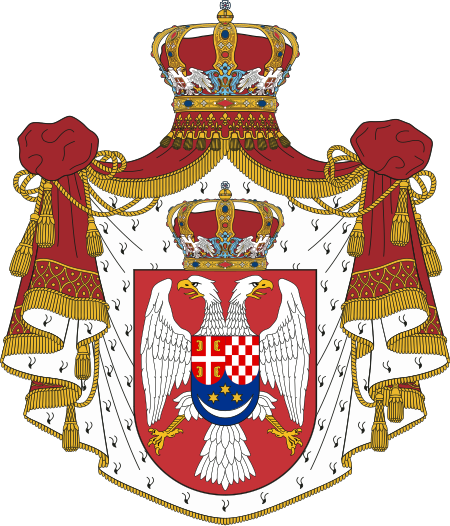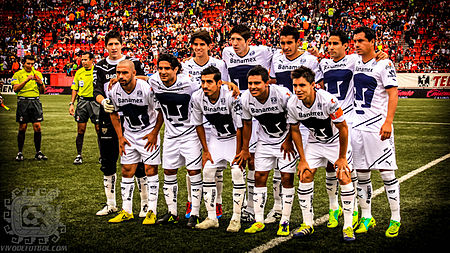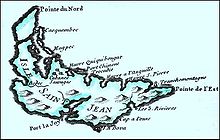History of Prince Edward Island
|
Read other articles:

Знамёнщик, ассистенты и адъютант 1-го Ударного отряда 8-й Армии (позднее переформирован в Корниловский ударный полк) поручик князь Ухтомский, 1917 год (РГАКФД). На касках — «Адамова голова»; на рукавах — синяя полковая эмблема[1] Уда́рные ча́сти Ру́сской а́рмии (уд�…

2022 conflict between Israel and Gaza 2022 Gaza–Israel clashesPart of the Israeli–Palestinian conflictTargeted killing of Tayseer al-Jabari, commander in the Islamic Jihad Movement in PalestineDate5–7 August 2022LocationGaza Strip and West BankResult Ceasefire on 23:30 (UTC+3), 7 August 2022Combatants Israel Israel Defense Forces Israeli Air Force Gaza Strip[1][2][3][4] Islamic Jihad Movement in Palestine (PIJ)[5][6][7&#…

Indian actress (1943–2002) For other people with the same name, see Devika (name). DevikaDevika in one of her moviesBornPrameela Devi(1943-04-25)25 April 1943Madras, Madras Presidency, British India (present day Chennai, Tamil Nadu, India)Died2 May 2002(2002-05-02) (aged 59)Chennai, Tamil Nadu, IndiaNationalityIndianOccupationActressYears active1954–1986Spouse Devadas (m. 1968; div. 1990)ChildrenKanaka (b.1973)RelativesRaghupathi …

Adaptions of Fantastic Four in films Logo from the 2005–2007 film series The superhero team Fantastic Four featured in Marvel Comics publication has appeared in four live-action films since its inception. The plots deal with four main characters, known formally as Reed Richards, Susan Storm, Ben Grimm, and Johnny Storm, and how they adapt to the superpowers they attain. Constantin Film bought the film rights for the characters in 1986. A low-budget film was produced in 1992 by New Horizon Stud…

Lambang Komune Misy-sur-Yonne. Misy-sur-YonneNegaraPrancisArondisemenProvinsKantonMontereau-Fault-YonneAntarkomuneCommunauté de communes des Deux FleuvesPemerintahan • Wali kota (2008-2014) Monique Jacquier • Populasi1749Kode INSEE/pos77293 / 2 Population sans doubles comptes: penghitungan tunggal penduduk di komune lain (e.g. mahasiswa dan personil militer). Misy-sur-Yonne merupakan sebuah komune di departemen Seine-et-Marne di region Île-de-France di utara-tengah…

Pullman Hotels and ResortsJenisAnak perusahaanIndustriHotelDidirikan2007; 17 tahun lalu (2007)KantorpusatParis, PrancisCabang153 (2022)[1]Wilayah operasiSeluruh duniaIndukAccorSitus webpullman.accor.com Pullman Hotels and Resorts adalah merek hotel kelas atas internasional[3][4] yang dimiliki oleh Accor. Per tahun 2022, Accor mengelola 153 hotel Pullman di seluruh dunia.[1] Sejarah Cikal bakal Pullman dapat ditelusuri hingga tahun 1872, ketika Compagnie Inter…

Pour les articles homonymes, voir Cloutier. Véronique CloutierVéronique Cloutier et son mari, l'humoriste et producteur Louis Morissette, au gala Les Olivier.BiographieNaissance 31 décembre 1974 (49 ans)LavalNationalité canadienneFormation Collège Jean-de-BrébeufActivités Actrice, productrice, humoriste, animatrice de radio, animatrice de télévision, femme d'affairesPériode d'activité depuis 1990Père Guy CloutierFratrie Stéphanie Cloutier (d)Conjoint Louis MorissetteAutres info…

拉米兹·阿利雅Ramiz Alia第1任阿尔巴尼亚總統任期1991年4月30日—1992年4月9日继任萨利·贝里沙阿尔巴尼亚人民议会主席团主席任期1982年11月22日—1991年4月30日前任哈奇·列希继任转任总统阿尔巴尼亚劳动党第一书记任期1985年4月13日—1991年5月4日前任恩维尔·霍查继任无(政党解散) 个人资料出生(1925-10-18)1925年10月18日 阿尔巴尼亚斯库台逝世2011年10月17日(2011歲—10—17)(85歲)…

Svetlana KuznetsovaKuznetsova di sesi latihan Aegon International 2016Nama lengkapSvetlana Aleksandrovna KuznetsovaСветла́на Алекса́ндровна Кузнецо́ваKebangsaan RusiaTempat tinggalMoskwa, Rusia[1]Lahir27 Juni 1985 (umur 38)Leningrad, RSFS Rusia, Uni SovietTinggi174 cm (5 ft 9 in)Memulai pro2000Total hadiahUS$ 22.781.615TunggalRekor (M–K)614–296 (67.47%)Gelar17 WTA, 1 ITFPeringkat tertinggiNo. 2 (10 September 2007)Peringkat saa…

1918–1992 country in Southeast Europe Not to be confused with the 1992–2006 state union between Serbia and Montenegro, called Federal Republic of Yugoslavia until 2003. For other uses, see Yugoslavia (disambiguation). YugoslaviaJugoslavijaЈугославија1918–19921941–1945: Axis occupation Top: Flag (1918–41)Bottom: Flag (1946–92) Top: Coat of arms(1918–41)Bottom: Emblem(1963–92) Anthem: National Anthem of the Kingdom of Yugoslavia (1919–1941)Hey, Slavs (1945–1992)…

Peta para Raja Muda di era Dinasti Qing. Wizurai Liangjiang Nama Tionghoa Hanzi tradisional: 兩江總督 Hanzi sederhana: 两江总督 Alih aksara Mandarin - Hanyu Pinyin: Liǎngjiāng Zǒngdū Gubernur Jenderal Dua Provinsi Yangtze dan Wilayah Sekitarnya yang Mengawasi Urusan Militer, Ketentuan dan Dana, Manajer Saluran Air, Direktur Urusan Sipil(nama lengkap jabatan) Hanzi tradisional: 總督兩江等處地方,提督軍務、糧餉、管理河道兼巡撫事 Hanzi sederhana: 总督两江等…

Land of the LostSutradaraBrad SilberlingProduserSid and Marty KrofftJimmy MillerDitulis olehChris HenchyDennis McNicholasBerdasarkanTelevision Series:Sid and Marty KrofftPemeranWill FerrellAnna FrielDanny McBrideJorma TacconePenata musikMichael GiacchinoSinematograferDion BeebePenyuntingPeter TeschnerDistributorUniversal PicturesTanggal rilis 5 Juni 2009 (2009-06-05) Durasi101 menitNegaraAmerika SerikatBahasaInggrisAnggaran$100 juta[1]Pendapatankotor$63.510.254[2] Land…

Topi kulit rakun Topi kulit rakun atau coonskin cap adalah penutup kepala yang terbuat dari kulit dan bulu rakun. Bentuk asli dari topi ini adalah olahan dari keseluruhan kulit rakun termasuk kepala dan ekor. Topi ini pertama kali dipakai oleh suku indian, kemudian banyak dipakai di Amerika dan oleh tentara Kanada pada abad ke-18 dan 19. Topi ini juga populer di Amerika Serikat dan Inggris pada tahun 50-an.[1] Referensi ^ Change, Vickie (15 April 2010). Coonskin Hats: Fur Real?. OC Weekl…

Adriana Magali Matiz Vargas Matiz durante una intervención en el Congreso de la República. Gobernadora del Tolima Actualmente en el cargo Desde el 1 de enero de 2024Predecesor Ricardo Orozco Valero Miembro de la Cámara de Representantes de ColombiaPor el Tolima 20 de julio de 2018-20 de julio de 2022 Información personalNacimiento 5 de octubre de 1975 (48 años)Colombia Residencia Ibagué, ColombiaNacionalidad ColombianaEducaciónEducada en Universidad Santo TomásUniversidad Externado de Co…

Disambiguazione – Se stai cercando l'omonimo dirigibile britannico, vedi R101 (dirigibile). R101Paese Italia Linguaitaliano Data di lancio10 marzo 1975 Share di ascolti2.065.000 (2 semestre 2023 ) EditoreMonradio S.r.l. (RadioMediaset) Nomi precedentiRadio Milano InternationalOne-O-One NetworkRadio 101 MottoEnjoy the Music! Sito webwww.r101.it/ DiffusioneTerrestreAnalogicoFM, in Italia MediasetMediaset 1Radio R101 (Italia)(DVB-T - FTA)Canale 771 DigitaleDAB, in Italia SatellitareTiv�…

Biblioteca AmbrosianaUbicazioneStato Italia RegioneLombardia CittàMilano IndirizzoPiazza Pio XI, 2 CaratteristicheTipoPubblica ISILIT-MI0133 Numero opere450 000 volumi e opuscoli, 3 000 incunaboli, 10 000 cinquecentine Stilearchitettura barocca italiana ArchitettoFrancesco Maria Richini, Fabio Mangone e Giacomo Moraglia Apertura1609 DirettoreMarco Navoni Sito web Modifica dati su Wikidata · Manuale «...questa biblioteca ambrosiana che Federigo ideò con sì animosa la…

Eastern Catholic church Not to be confused with the Syro-Malabar Church, another Eastern Catholic body. Syro-Malankara Catholic ChurchOld image of Cathedral of Saint Mary, Pattom, TrivandrumTypeParticular church (sui iuris)ClassificationEastern CatholicOrientationEastern ChristianityScripturePeshitta[1]TheologyCatholic theologyPolityEpiscopal polityPopeFrancisMajor ArchbishopBaselios CleemisParishes1096[citation needed]LiturgyWest Syriac Rite (Malankara Rite)HeadquartersCathedral…

Association football club in Mexico City, Mexico This article is about the men's professional association football team. For the women's team associated to the same club, see Club Universidad Nacional (women). For the American football team, see Pumas CU. Football clubClub Universidad NacionalFull nameClub Universidad Nacional, A.C.[1]Nickname(s)Pumas Universitarios (Collegiates) Universidad (University) Auriazules (Gold-and-Blues)[2] Los de Pedregal (The Guys from Pedregal)[…

Questa voce o sezione sull'argomento nobili austriaci non cita le fonti necessarie o quelle presenti sono insufficienti. Puoi migliorare questa voce aggiungendo citazioni da fonti attendibili secondo le linee guida sull'uso delle fonti. Rodolfo II d'AsburgoRe Rodolfo I infeuda i suoi due figli Alberto e Rodolfo II con i ducati d'Austria, Stiria, Carinzia e Carniola di Franz Gaul, 1906Duca d'AustriaIn caricadicembre 1282 –1º giugno 1283(con il fratello Alberto I) PredecessoreRodolfo …

Arthur AylesworthAylesworth pada 1912LahirArthur Preston Aylesworth(1883-08-12)12 Agustus 1883Apponaug, Rhode Island, Amerika SerikatMeninggal26 Juni 1946(1946-06-26) (umur 62)Los Angeles, California, Amerika SerikatMakamChapel of the Pines Crematory, Los Angeles, California, Amerika SerikatPekerjaanPemeranTahun aktif1915–1946Suami/istriElizabeth AylesworthSadie Harris Arthur Preston Aylesworth (12 Agustus 1883 – 26 Juni 1946)[1] adalah seorang pemeran panggun…






